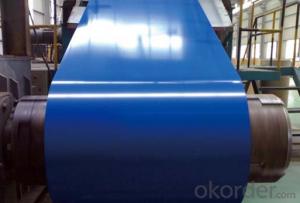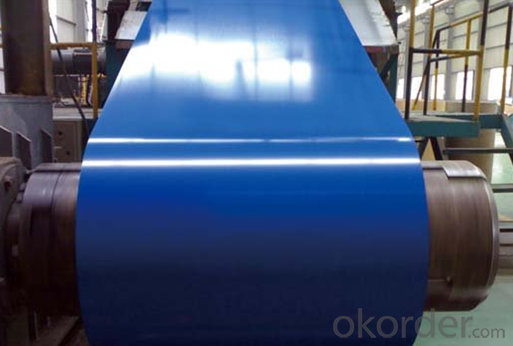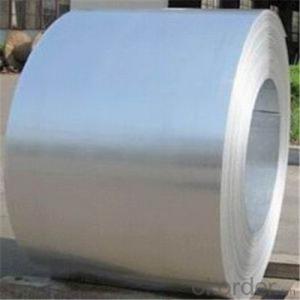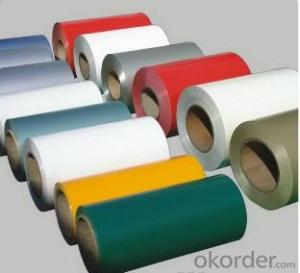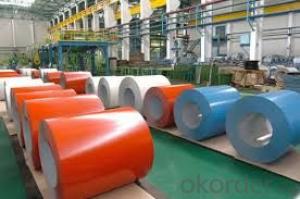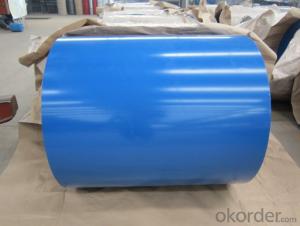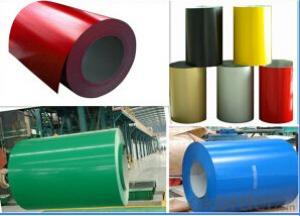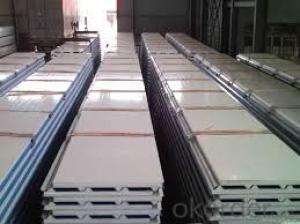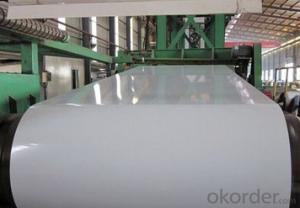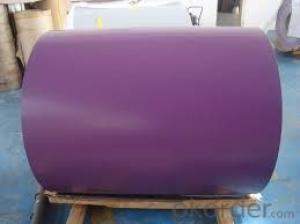PPGI Prepainted Galvanized Steel Coil With Different Width
- Loading Port:
- China main port
- Payment Terms:
- TT OR LC
- Min Order Qty:
- 25 m.t.
- Supply Capability:
- 10000 m.t./month
OKorder Service Pledge
OKorder Financial Service
You Might Also Like
0.3mm Thickness PPGI Prepainted Galvanized Steel Coil With Different Width
Product Description
Specifications:
1. Thickness: 0.12mm-1.3mm
2. Width: 600mm-1250mm
3. Length: According to client's demands
4. Top paint: 15 to 25 um (5 um + 12-20 um)
Back paint: 7 +/- 2 um
5. Gloss: Normal or High gloss
6. Zinc coating: Z50-Z275G/psm
7. Inside Diameter: 508mm/610mm
8. Outside Diameter: 1000mm-1500mm
9. Coil weight: 3-8 tons
10. Payment: T/T, L/C, D/P, Paypal, Western Union
11. Trade Term: FOB, CFR, CIF
12. MOQ: 25 Mt
13. Package: Export standard package or as request
14. Shipment: By container
15. Standard: AISI, ASTM, BS, DIN, GB, JIS
16. Grade: JIS G3322, CGLCC, ASTM A755, CS-B
Company Introduction:
CNBM Steel is mainly engaged in producing and exporting galvanized steel coil/sheet(GI), prepainted galvanized steel coil/sheet(PPGI), corrugated galvanized sheet and tinplate coil/sheet. CNBM Steel has also become the agent of hot rolled coil/sheet, cold rolled coil/sheet, I beam, angle steel and channel steel.
Company Culture:
Take customers as the honoured, Take quality as the foundation!
Strive For Survival On The Basis Of Quality!
Why Us:
1. ISO, BV, CE, SGS approved
2. Competitive price and quality from our own factory
3. Efficient service team online for 24 hours
4. Smooth production ability(50000tons/month)
5. Quick delivery and standard exporting package
6. Flexible payment with T/T, L/C, Paypal, etc
Name | 0.3mm Thickness PPGI Prepainted Galvanized Steel Coil |
Resin constructure | Double painting and double baking process |
Productivity | 150,000Tons/year |
Thickness | 0.12-1.3mm |
Width | 600-1250mm |
Coil Weight | 3-8 Tons |
Inside Diameter | 508mm Or 610mm |
Outside Diameter | 1000mm-1500mm |
Zinc Coating | Z50-Z275G/psm |
Painting | Top: 15 to 25 um (5 um + 12-20 um) back: 7 +/- 2 um |
Standard | JIS G3322 CGLCC ASTM A755 CS-B |
SurfSurface coating | PE, SMP, HDP, PVDF |
Back side coatingcolor | Light grey, white and so on |
Application | PPGI is featured with light-weight, good looking and |
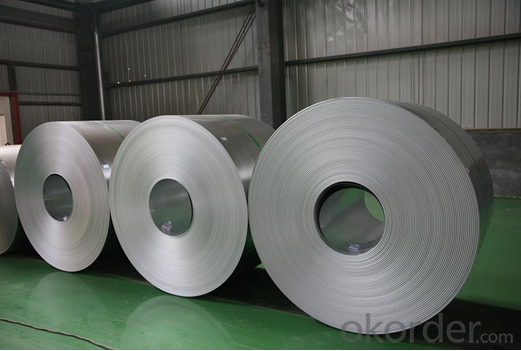
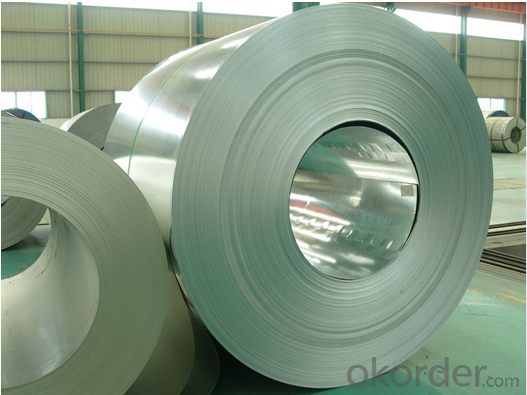
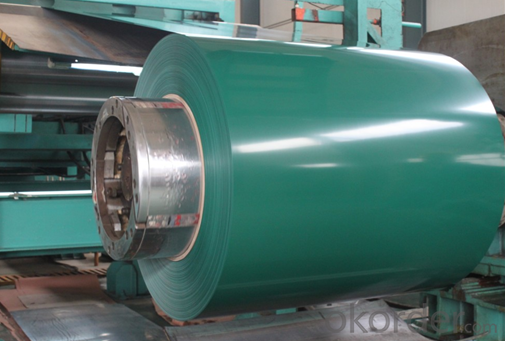
FAQ
1.Do you have QC teams?
Yeah, sure, our QC team is very important, they will keep the quality control for our products.
2. What's your normal delivery time?
Our delivery time about 10-20days for standard sizes, if you have other requirements like hardness and width ,it is about 20-40days. But don't worry ,we also try our best for the delivery time ,because time longer and our cost is higher.
3.Are the products tested before shipping?
Yes, all of our PPGI and GI was qualified before shipping. We test every batch every day.
- Q: What is the yield strength of steel coils?
- The yield strength of steel coils can vary depending on the specific grade and composition of the steel. However, the typical yield strength of steel coils ranges from 300 to 600 megapascals (MPa).
- Q: How are steel coils used in the production of food processing equipment?
- Due to their advantageous properties, steel coils find widespread use in the manufacturing of food processing equipment. These coils, typically crafted from stainless steel, are employed in the production of a diverse array of equipment, including mixers, blenders, conveyors, ovens, and fryers. The excellent resistance to corrosion exhibited by steel coils is one of the primary reasons they are preferred for use in food processing equipment. Stainless steel coils possess a high resistance to rust and can endure exposure to moisture and various food substances without deteriorating. This crucial characteristic ensures that the equipment remains hygienic and safe for food processing. In addition, steel coils provide exceptional strength and durability, enabling food processing equipment to withstand heavy use and harsh operating conditions. These coils can be shaped into various forms and sizes, making it possible to fabricate complex equipment components. This versatility facilitates the design and construction of equipment that is both efficient and reliable in processing a wide range of food products. Moreover, steel coils are simple to clean and maintain. The smooth surface of stainless steel prevents staining and simplifies the removal of food residues, thereby preventing the growth of bacteria. Regular cleaning and sanitation of food processing equipment are indispensable in maintaining food safety standards, and steel coils streamline this process, making it more effective. Furthermore, steel coils possess excellent heat conductivity properties, which facilitate efficient heat transfer in food processing equipment, such as ovens and fryers. This allows for precise temperature control and uniform cooking, ensuring consistent quality in the processed food products. In summary, steel coils assume a vital role in the production of food processing equipment by providing corrosion resistance, strength, durability, ease of cleaning, and efficient heat transfer. These qualities render steel coils an ideal material for manufacturing equipment that meets the stringent hygiene, safety, and quality standards required in the food processing industry.
- Q: How is the critical temperature of structural steel affected by fireproofing? What temperatures can fireproofed structural steel withstand?
- mix the fire retardant with cement, let it harden fast to superstructure. this will create better stability and will not be dislodged in case of impact.
- Q: how much pressure can steel withstand? and how much pressure can concrete withstand? per m3 or cm3? thanks
- Your question is not specific,there are many types of Concrete according to ratio and many types of steel but if want general answer,Concrete is good for compression and for 1:2:4 Cement-Sand-Gravel Ratio up to 4000 psi but very weak in tension where as tor steel is good for tension and is about 70000-80000 psi .
- Q: I'm kind of confused as to how the difference between a stainless steel and blued steel firearm is sometimes only $20 or so. Isn't stainless steel fairly more expensive to manufacture than plain carbon steel? Are some stainless steel firearms simply stainless steel finished with carbon steel underneath?
- Fill the pot up w/cold water to cover the burned on rice. Bring it up to a boil. Do it again w/some high powered soap in the mix. This time let the water sit in the pan until its luke warm, dump it out and scrub it up w/the plastic scouring pad. You should be all set.
- Q: How are steel coils used in the manufacturing of marine equipment?
- Steel coils are used in the manufacturing of marine equipment as they provide the necessary strength and durability required for the construction of various components such as ship hulls, bulkheads, decks, and structural supports. These coils are typically used as raw material for cutting, shaping, and welding into the required shapes and sizes, ensuring the marine equipment can withstand the harsh conditions of the sea and maintain its structural integrity.
- Q: How are steel coils protected from condensation?
- Steel coils are typically protected from condensation by applying a thin layer of oil or another corrosion-resistant coating to the surface. This acts as a barrier, preventing moisture from coming into direct contact with the steel and minimizing the risk of condensation forming. Additionally, the coils are often stored in a controlled environment with proper ventilation to minimize humidity levels and prevent condensation from occurring.
- Q: How are steel coils used in the production of lighting fixtures?
- Lighting fixtures rely on steel coils as a vital element. These coils are typically crafted from top-notch steel, which imparts durability and strength to the end result. In the manufacturing process, the steel coils undergo an initial uncoiling before being processed through a series of machines. These machines cut and mold the steel into various parts and components essential for lighting fixtures. To achieve the desired shapes and sizes, the steel is often bent, stamped, or rolled. These parts may include the base, frame, arms, or other structural elements of the lighting fixture. Once the steel components are shaped, they are subjected to further processing and finishing. This may involve techniques such as welding, polishing, or coating to enhance the steel's appearance and protect it from corrosion. When the steel parts are finalized, they are combined with other components like electrical wiring, bulbs, shades, and switches to create the complete lighting fixture. The utilization of steel coils in lighting fixture production guarantees that the final products are robust, long-lasting, and capable of enduring various environmental conditions. Steel's strength allows for the creation of intricate designs and shapes, enabling manufacturers to produce lighting fixtures that are not only functional but also visually appealing. All in all, steel coils play a pivotal role in lighting fixture production by providing the necessary strength, durability, and versatility required for these products.
- Q: So...I'm learning about how steel is made and I'm wondering if there is a more environmentally friendy method. I view it as unfriendly b/c of the oxygen that is injected when the steel is in the blast furnace or electric arc furnace. This oxygen bonds w/ the carbon to produce CO and CO2. THis is necessary to reduce the amount of carbon content to produce harder steels. So what other methods are there that can be used w/o having to end up w/ co and co2? thanks
- From what I understand of it, US steel is better as the steel is more recycled than Canadian, so a lot of that oxygen / CO2 has already taken place compared to working from ore. The second reason US steel is environmentally ahead of Canadian is that US tends to use Electric Arc, while Canadian uses Basic Oxygen, Basic Oxygen uses more energy than electric arc, and I think it also uses more oxygen, but I would suspect that oxygen that it uses is 'waste oxygen' and not converted into Co2 because the Co2 process is limited by the carbon, and steel only has so much carbon.
- Q: I want to replace the old refrigator within the next 6 months........ Is the trend to buy a stainless steel refrigerator? Some magazines and internet sites are pointing me that direction. What are the pro's and con's ? I like the color bisque, or cream-color as well, or better, than stainless steel. What would be the reasons to buy stainless steel...is it becoming the most popular color ?
- It's not about color necessarily. Stainless steel is easier to clean and for the most part scratch resistant. It's easier to take care of.
Send your message to us
PPGI Prepainted Galvanized Steel Coil With Different Width
- Loading Port:
- China main port
- Payment Terms:
- TT OR LC
- Min Order Qty:
- 25 m.t.
- Supply Capability:
- 10000 m.t./month
OKorder Service Pledge
OKorder Financial Service
Similar products
Hot products
Hot Searches
Related keywords
